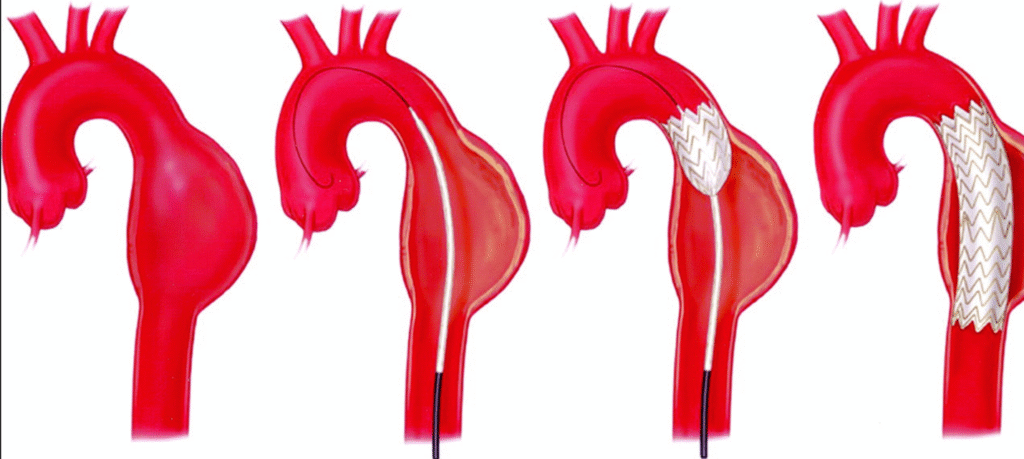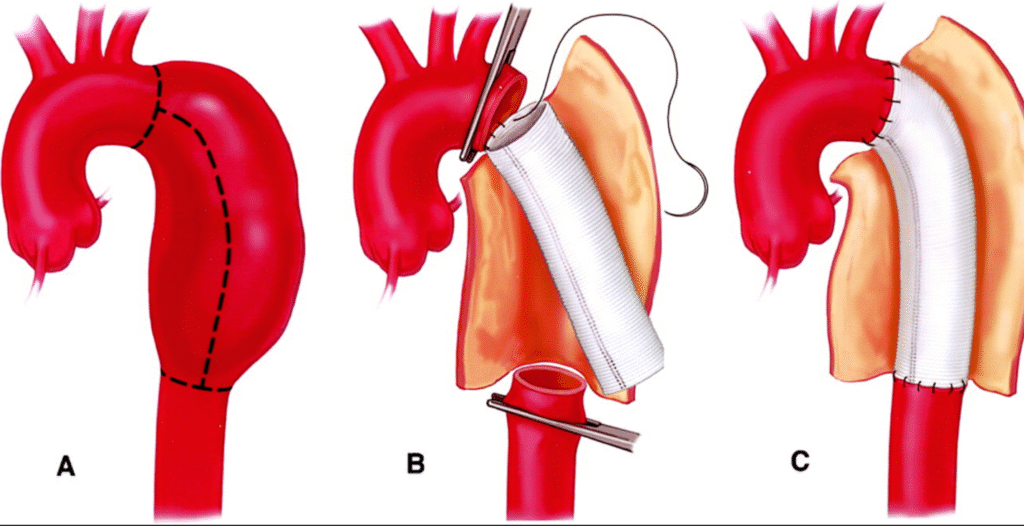What Is an Aortic Dissection?
An aortic dissection is a life-threatening condition where a tear forms in the inner layer of the aorta, allowing blood to flow between the layers of the vessel wall and split them apart. This condition demands immediate medical attention.
There are two major types:
- Type A Dissection: Involves the ascending aorta (near the heart); requires emergency open-heart surgery by cardiac surgeons.
- Type B Dissection: Involves the descending thoracic aorta (beyond the arch); managed by vascular surgeons like those at Vascular Clinic.
We specialize in Type B aortic dissections, offering urgent hospital-based care and long-term follow-up to protect your health and prevent complications.



Initial Management: Stabilizing the Dissection
When a Type B dissection is diagnosed, the first priority is medical stabilization, typically in the intensive care unit (ICU). Our vascular specialists work closely with ICU teams to:
- Aggressively control blood pressure and heart rate to reduce stress on the aortic wall
- Manage pain and anxiety, which can worsen the dissection if uncontrolled
- Monitor for organ malperfusion, ongoing bleeding, or signs of rupture
For uncomplicated Type B dissections (where blood flow to organs is preserved and there’s no rupture), medical management and observation may be sufficient. Over time, the torn inner layer may scar down, and no surgical intervention is required.
When Is Surgery Needed?
In some cases, the dissection causes serious complications such as:
- Poor blood flow to vital organs (e.g., kidneys, intestines, spinal cord)
- Enlargement or weakening of the aortic wall
- Risk of rupture or continued bleeding
In these situations, we perform Thoracic Endovascular Aortic Repair (TEVAR) — a minimally invasive stent graft procedure designed to seal the tear and restore normal blood flow.



TEVAR: Minimally Invasive Repair of Type B Dissections
TEVAR involves:
- Inserting a stent graft through a small puncture in the groin
- Navigating the device through the blood vessels to the descending thoracic aorta
- Placing the stent graft inside the aorta to seal the dissection, redirecting blood into the true lumen and reducing pressure on the false channel
Key Benefits:
- Avoids the need for open chest surgery
- Performed under general anesthesia in a hospital
- Typically 2–4 days hospital stay
- Shorter recovery, fewer complications



Long-Term Monitoring and Surveillance
Even if no surgery is initially required, long-term follow-up is essential. Type B dissections may evolve into aneurysms over time that eventually require repair.
At Vascular Clinic, we provide:
- Serial imaging at set intervals (e.g., 1 month, 6 months, annually)
- Clinic visits with vascular specialists to review findings and manage medications
- A structured surveillance program to ensure timely intervention if progression occurs
What to Expect
Before Intervention (in the ICU):
- Imaging (CT angiography) to assess the extent of the dissection
- Blood pressure and pain control
- Daily assessment by our vascular surgery team
If TEVAR Is Required:
- Preoperative planning using detailed 3D imaging
- Stent graft placement in a high-tech vascular suite
- Postoperative monitoring to ensure aortic healing
After Discharge:
- Serial imaging (CT angiography) every few months to monitor the dissection
- Routine clinic visits for blood pressure checks, medication adjustments, and surveillance
- Ongoing evaluation to watch for aneurysm formation—a known risk after dissection
Frequently Asked Questions
What causes an aortic dissection?
Common causes include uncontrolled high blood pressure, connective tissue disorders, or a history of aortic disease or aneurysm.
What’s the difference between Type A and Type B?
Type A affects the ascending aorta and requires emergency open-heart surgery. Type B affects the descending aorta and is managed by vascular surgeons, often without surgery at first.
Can I avoid surgery for a Type B dissection?
Yes many patients are managed with medications and monitoring alone, provided there are no complications. Surgery is only recommended if the dissection becomes unstable or dangerous.
Will I need imaging long-term?
Yes. Routine CT scans are crucial to detect changes in the aorta over time, especially to look for delayed aneurysm formation
Why Choose Vascular Clinic?
- Specialized Care for Type B Aortic Dissections
- On-Call Emergency Vascular Surgeons Available 24/7
- Seamless ICU Collaboration and Hospital-Based Care
- Minimally Invasive TEVAR Expertise
- Long-Term Surveillance with Personalized Follow-Up
We guide you and your family through every phase—from ICU stabilization to outpatient recovery and lifelong monitoring—with clarity, compassion, and cutting-edge care.




